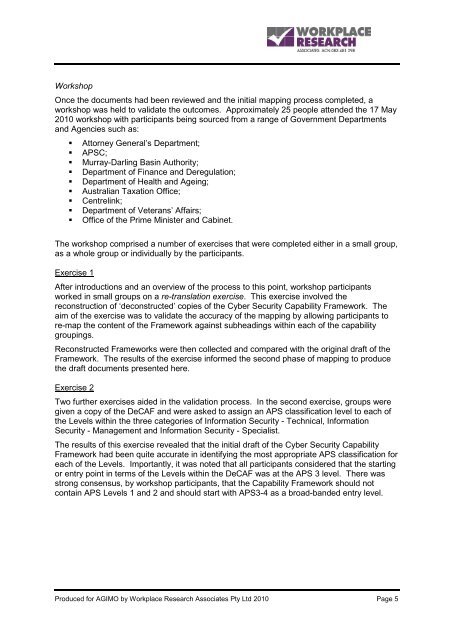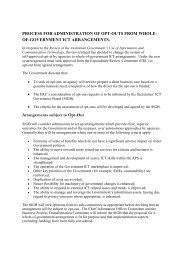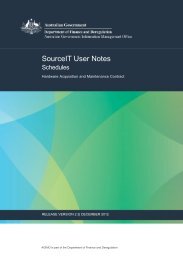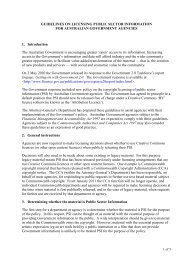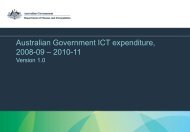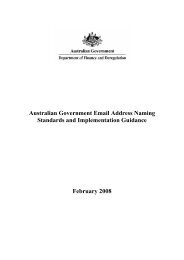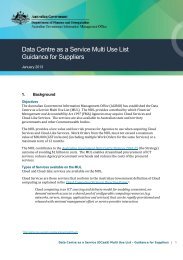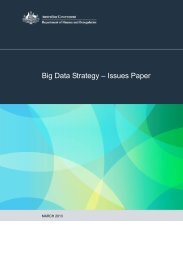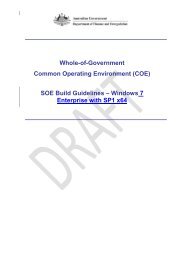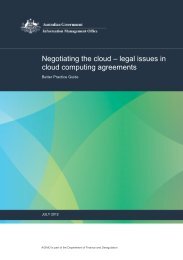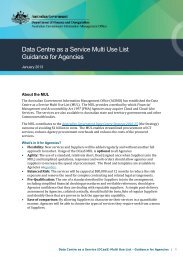Cyber Security Capability Framework & Mapping of ISM Roles - agimo
Cyber Security Capability Framework & Mapping of ISM Roles - agimo
Cyber Security Capability Framework & Mapping of ISM Roles - agimo
You also want an ePaper? Increase the reach of your titles
YUMPU automatically turns print PDFs into web optimized ePapers that Google loves.
WorkshopOnce the documents had been reviewed and the initial mapping process completed, aworkshop was held to validate the outcomes. Approximately 25 people attended the 17 May2010 workshop with participants being sourced from a range <strong>of</strong> Government Departmentsand Agencies such as:• Attorney General’s Department;• APSC;• Murray-Darling Basin Authority;• Department <strong>of</strong> Finance and Deregulation;• Department <strong>of</strong> Health and Ageing;• Australian Taxation Office;• Centrelink;• Department <strong>of</strong> Veterans’ Affairs;• Office <strong>of</strong> the Prime Minister and Cabinet.The workshop comprised a number <strong>of</strong> exercises that were completed either in a small group,as a whole group or individually by the participants.Exercise 1After introductions and an overview <strong>of</strong> the process to this point, workshop participantsworked in small groups on a re-translation exercise. This exercise involved thereconstruction <strong>of</strong> ‘deconstructed’ copies <strong>of</strong> the <strong>Cyber</strong> <strong>Security</strong> <strong>Capability</strong> <strong>Framework</strong>. Theaim <strong>of</strong> the exercise was to validate the accuracy <strong>of</strong> the mapping by allowing participants tore-map the content <strong>of</strong> the <strong>Framework</strong> against subheadings within each <strong>of</strong> the capabilitygroupings.Reconstructed <strong>Framework</strong>s were then collected and compared with the original draft <strong>of</strong> the<strong>Framework</strong>. The results <strong>of</strong> the exercise informed the second phase <strong>of</strong> mapping to producethe draft documents presented here.Exercise 2Two further exercises aided in the validation process. In the second exercise, groups weregiven a copy <strong>of</strong> the DeCAF and were asked to assign an APS classification level to each <strong>of</strong>the Levels within the three categories <strong>of</strong> Information <strong>Security</strong> - Technical, Information<strong>Security</strong> - Management and Information <strong>Security</strong> - Specialist.The results <strong>of</strong> this exercise revealed that the initial draft <strong>of</strong> the <strong>Cyber</strong> <strong>Security</strong> <strong>Capability</strong><strong>Framework</strong> had been quite accurate in identifying the most appropriate APS classification foreach <strong>of</strong> the Levels. Importantly, it was noted that all participants considered that the startingor entry point in terms <strong>of</strong> the Levels within the DeCAF was at the APS 3 level. There wasstrong consensus, by workshop participants, that the <strong>Capability</strong> <strong>Framework</strong> should notcontain APS Levels 1 and 2 and should start with APS3-4 as a broad-banded entry level.Produced for AGIMO by Workplace Research Associates Pty Ltd 2010 Page 5


